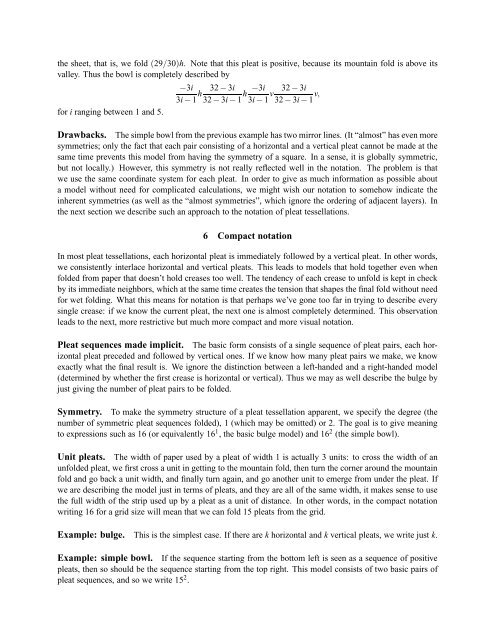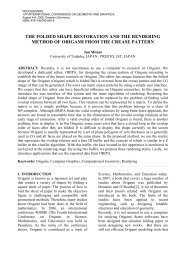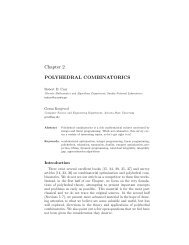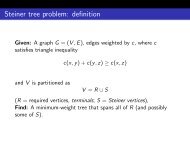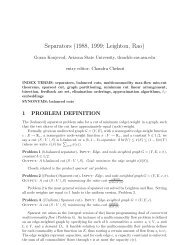Notation for a class of paperfolded models - Organic Origami
Notation for a class of paperfolded models - Organic Origami
Notation for a class of paperfolded models - Organic Origami
Create successful ePaper yourself
Turn your PDF publications into a flip-book with our unique Google optimized e-Paper software.
the sheet, that is, we fold (29/30)h. Note that this pleat is positive, because its mountain fold is above its<br />
valley. Thus the bowl is completely described by<br />
<strong>for</strong> i ranging between 1 and 5.<br />
−3i<br />
3i − 1 h 32 − 3i<br />
32 − 3i − 1 h −3i<br />
3i − 1 v 32 − 3i<br />
32 − 3i − 1 v,<br />
Drawbacks. The simple bowl from the previous example has two mirror lines. (It “almost” has even more<br />
symmetries; only the fact that each pair consisting <strong>of</strong> a horizontal and a vertical pleat cannot be made at the<br />
same time prevents this model from having the symmetry <strong>of</strong> a square. In a sense, it is globally symmetric,<br />
but not locally.) However, this symmetry is not really reflected well in the notation. The problem is that<br />
we use the same coordinate system <strong>for</strong> each pleat. In order to give as much in<strong>for</strong>mation as possible about<br />
a model without need <strong>for</strong> complicated calculations, we might wish our notation to somehow indicate the<br />
inherent symmetries (as well as the “almost symmetries”, which ignore the ordering <strong>of</strong> adjacent layers). In<br />
the next section we describe such an approach to the notation <strong>of</strong> pleat tessellations.<br />
6 Compact notation<br />
In most pleat tessellations, each horizontal pleat is immediately followed by a vertical pleat. In other words,<br />
we consistently interlace horizontal and vertical pleats. This leads to <strong>models</strong> that hold together even when<br />
folded from paper that doesn’t hold creases too well. The tendency <strong>of</strong> each crease to unfold is kept in check<br />
by its immediate neighbors, which at the same time creates the tension that shapes the final fold without need<br />
<strong>for</strong> wet folding. What this means <strong>for</strong> notation is that perhaps we’ve gone too far in trying to describe every<br />
single crease: if we know the current pleat, the next one is almost completely determined. This observation<br />
leads to the next, more restrictive but much more compact and more visual notation.<br />
Pleat sequences made implicit. The basic <strong>for</strong>m consists <strong>of</strong> a single sequence <strong>of</strong> pleat pairs, each horizontal<br />
pleat preceded and followed by vertical ones. If we know how many pleat pairs we make, we know<br />
exactly what the final result is. We ignore the distinction between a left-handed and a right-handed model<br />
(determined by whether the first crease is horizontal or vertical). Thus we may as well describe the bulge by<br />
just giving the number <strong>of</strong> pleat pairs to be folded.<br />
Symmetry. To make the symmetry structure <strong>of</strong> a pleat tessellation apparent, we specify the degree (the<br />
number <strong>of</strong> symmetric pleat sequences folded), 1 (which may be omitted) or 2. The goal is to give meaning<br />
to expressions such as 16 (or equivalently 16 1 , the basic bulge model) and 16 2 (the simple bowl).<br />
Unit pleats. The width <strong>of</strong> paper used by a pleat <strong>of</strong> width 1 is actually 3 units: to cross the width <strong>of</strong> an<br />
unfolded pleat, we first cross a unit in getting to the mountain fold, then turn the corner around the mountain<br />
fold and go back a unit width, and finally turn again, and go another unit to emerge from under the pleat. If<br />
we are describing the model just in terms <strong>of</strong> pleats, and they are all <strong>of</strong> the same width, it makes sense to use<br />
the full width <strong>of</strong> the strip used up by a pleat as a unit <strong>of</strong> distance. In other words, in the compact notation<br />
writing 16 <strong>for</strong> a grid size will mean that we can fold 15 pleats from the grid.<br />
Example: bulge. This is the simplest case. If there are k horizontal and k vertical pleats, we write just k.<br />
Example: simple bowl. If the sequence starting from the bottom left is seen as a sequence <strong>of</strong> positive<br />
pleats, then so should be the sequence starting from the top right. This model consists <strong>of</strong> two basic pairs <strong>of</strong><br />
pleat sequences, and so we write 15 2 .


